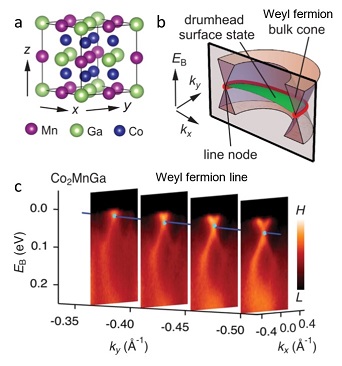Topological phases in quantum magnets have recently attracted intense research interest. One magnetic topological phase is the Weyl fermion line. Unlike Weyl point fermions [1-2] which exhibit a linear band crossing at a discrete point in momentum space, Weyl lines exhibit linear band crossings along an entire curve in momentum space. They are associated with exotic quasiparticles beyond the familiar language of particle physics, corresponding to an infinite train of lower-dimensional Weyl fermions. Weyl fermion lines can arise when bands exhibit spin-splitting as well as mirror symmetry. Since magnetism naturally brings about spin-splitting, and since many crystal structures exhibit mirror symmetry, Weyl fermion lines emerge naturally in quantum magnets. One of the hallmarks of Weyl lines is that they act as sources of electronic Berry curvature, leading to a large anomalous Hall effect as well as other exotic quantum transport and optical response potentially useful for spin-optoelectronics and novel quantum devices.

Figure 1. (a) Crystal structure of Co2MnGa. (b) Schematic of the electronic topology, consisting of bulk Weyl fermion line and drumhead surface state. (c) ARPES observation of bulk Weyl fermion line.
Recently, Belopolski et al. studied the room temperature ferromagnet Co2MnGa, searching for signatures of quantum magnetic topology. The material is ferromagnetic, bringing about large spin-splitting, and its crystal structure exhibits many mirror planes (Fig. 1a), so that one might expect Weyl lines in the electronic structure (Fig. 1b). They investigated the crystal using angle-resolved photoemission spectroscopy (ARPES) provided by the state-of-the-art Beam Line 5-2 recently constructed at SSRL. The technique, a sophisticated version of the photoelectric effect, allows direct measurement of a crystal’s electronic structure and quasiparticle excitations, making it useful for exploring the quantum state of Co2MnGa. Using ARPES, the researchers observed band crossings extending along a line in momentum space, the smoking-gun signature of a topological Weyl line (Fig. 1c). They further observed additional electronic states localized near the surface of the sample and connecting the topological Weyl lines in momentum space, providing evidence for the topological bulk-boundary correspondence. To complement their ARPES results, the researchers used quantum transport to study the anomalous Hall effect (AHE) in Co2MnGa. They extracted the intrinsic component of the AHE, which is the component arising from the Berry curvature field in the electronic structure. They then calculated the expected Berry curvature and its flux from the topological Weyl lines, based on ARPES and theoretical calculations [3]. The two values of intrinsic AHE, from the quantum transport side and the ARPES side, showed remarkable agreement.
Altogether, these findings provide evidence from three points of view that Co2MnGa is a quantum topological magnet in three dimensions, the first such phase discovered: (1) the direct observation of the topological Weyl lines in the sample bulk; (2) associated drumhead states on the sample surface; and (3) presentation and analysis of the anomalous Hall effect based on topological band theory. Notably, the high Curie temperature, TC = 690 K, well above room temperature, points the way to technological applications based on this quantum material’s novel topological magnetism.
- S. Jia, S.-Y. Xu, and M. Z. Hasan, “Weyl Semimetals, Fermi Arcs and Chiral Anomalies”, Nat. Mat. 15, 1140 (2016).
- M. Zahid Hasan, S.-Y. Xu, I. Belopolski, and S.-M. Huang, “Discovery of Weyl Fermion Semimetals and Topological Fermi Arc States”, Ann. Rev. Cond. Matt. Phys. 8, 289 (2017).
- Guoqing Chang et al., “Topological Hopf and Chain Link Semimetal States and Their Application to Co2MnGa”, Phys. Rev. Lett. 119, 156401 (2017).
I. Belopolski, K. Manna, D. S. Sanchez, G. Chang, B. Ernst, J. Yin, S. S. Zhang, T. Cochran, N. Shumiya, H. Zheng, B. Singh, G. Bian, D. Multer, M. Litskevich, X. Zhou, S.-M. Huang, B. Wang, T.-R. Chang, S.-Y. Xu, A. Bansil, C. Felser, H. Lin and M. Z. Hasan, "Discovery of Topological Weyl Fermion Lines and Drumhead Surface States in a Room Temperature Magnet", Science 365, 1278 (2019) doi: 10.1126/science.aav2327




